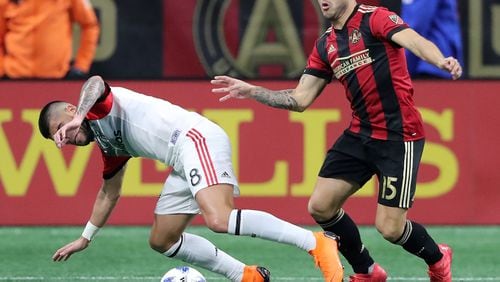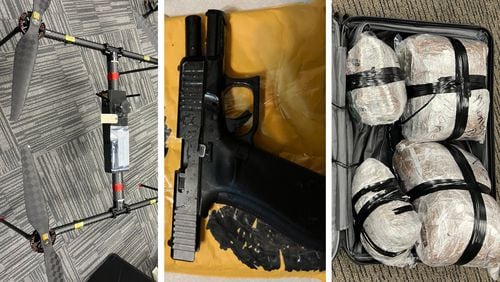Atlanta United’s Hector Villalba said it felt good to get minutes in the second half of last week’s 4-1 win against Montreal at Mercedes-Benz Stadium.
After missing two games because of a strained hamstring that he said is now fully healed, Villalba came on as a tactical sub in the 46th minute to try to unlock a Montreal defense that had stymied the Five Stripes.
Because of his speed and scoring ability, Villalba will get more minutes, likely starting on Saturday at Chicago. The questions are how many and at what position.
Villalba said on Tuesday that there's no way to accommodate all of the attacking talent the team has into any formation the team typically uses. Along with Villalba are Josef Martinez and Miguel Almiron, who are tied for the MLS lead with six goals each, Ezequiel Barco, who looked very sharp in his second start against the Impact and Darlington Nagbe, who is also growing into his role as a bridge midfielder who either drops back to work defensive midfielder Jeff Larentowicz or moves up and connects with Almiron, Martinez and Barco, depending upon the situation. The team must have defenders, so dropping Larentowicz wouldn't be prudent for a defense that has allowed just nine goals, tied for third-fewest in the league this season.
“He can only fit 11 on the field,” Villalba said of manager Gerardo Martino. “Whoever the best 11 are during the week of training are going to play. You have to prepare thinking like that, working hard every day in training.
“But I think it’s good. I think it serves the team well that we have a lot of good players, a lot of guys who are fighting for their spots, so you have to prove it during the week and during the games. You know you have to show that you can win, that the team is united and I think that is good for our group.”
Villalba was one of four players in MLS last season who scored at least 10 goals and had 10 assists. The Argentinian finished with 13 goals and 11 assists.
He hasn’t had the same obvious statistical impact this season with one goal and two assists, all of which came in the same game against D.C. United.
Villalba said he is comfortable playing either as the second, central striker in the 3-5-2 formation the team has used in seven of eight games this season, or out wide as forward in the 4-3-3 formation the team used almost exclusively last season and used in the season-opening 4-0 loss at Houston.
Villalba’s speed is particularly dangerous out wide where he can run at a single defender, rather than as a striker when there is typically a cluster of defenders between him and the goal.
Martino said Villalba played very well in the second half of the game against Montreal. Martino’s idea of playing Villalba beside Martinez opened up more space on the flanks and in the final third because the centerbacks and defensive midfielders were forced to contract their shape to.
Atlanta United soon started pushing more players forward to push Montreal even deeper into its own half.
Nagbe used that space to put in a cross to Chris McCann, whose header hit Chris Duvall’s hand and resulted in the penalty kick by Almiron that tied the game at 1-1. From there, Atlanta United added three more unanswered goals for the win.







